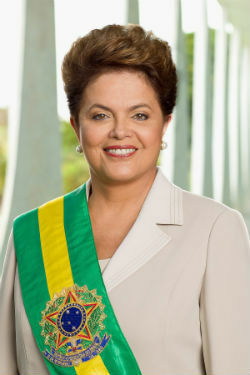DilmaVanaRousseff was the 36th President of the Federative Republic of Brazil. She was the first woman to hold the presidency of Brazil and the third head of state in the country.
Accused of administrative impropriety, she did not complete her second term due to the impeachment process.

Biography
Dilma Rousseff was born on December 14, 1947, in Belo Horizonte/MG.
Raised in an upper-middle class environment, her parents were a Bulgarian lawyer, Pedro Rousseff, and her teacher, Dilma Jane da Silva. In addition to Dilma, the couple had two more children.
During high school, Dilma participated in political activities in the student movement in Belo Horizonte. At the time, she was 16 years old and was fighting the military dictatorship established in Brazil in 1964.
Military dictatorship
In the period of military dictatorship in Brazil, she served as a member of the groups Colina (Command of National Liberation) and the VAR-Palmares (Vanguarda Armada Revolucionaria Palmares), both of which had a Marxist orientation.
In these organizations, Dilma was responsible for giving instructions on socialism, planning actions, storing weapons and documents. Despite not having participated in armed struggles, Dilma was tried by a military court on the charge of subversion for publicly disagreeing with the dictatorship. The punishment was based on Decree No. 477, of the AI-5 (Institutional Act No. 5).
For this reason, she served her sentence from 1970 to 1972, in São Paulo. While in prison, Dilma Rousseff was tortured.
The conviction also prevented her from resuming her studies at UFMG (Federal University of Minas Gerais).
A year after leaving prison she went to live in the city of Porto Alegre, capital of Rio Grande do Sul. In the hometown of husband Carlos Franklin Paixão de Araújo, their only daughter, Paula Rousseff Araújo, was born.
Also in Porto Alegre, she would resume her studies at the Faculty of Economics at the Federal University of Rio Grande do Sul (UFRS).
political trajectory
In Rio Grande do Sul, Dilma spends most of her professional and political life before reaching the Presidency. With her husband, she acted in the foundation of the PDT (Democratic Labor Party).
She was PDT's bench advisor from 1980 to 1985. In 1986, she was appointed head of the Porto Alegre Finance Department.
He participated in the campaign of Leonel Brizola (1922 - 2004) for the Presidency of the Republic in 1989, which took place in two rounds. In the second, the PDT supported the PT (Workers' Party) candidate, Luiz Inácio Lula da Silva.
The winner was the right-wing candidate, Fernando Collor de Mello, from the National Reconstruction Party (PRN) later removed for a crime of responsibility that culminated in his Impeachment.
Between 1990 and 1993, Dilma remained in the secretariat of the government of Rio Grande do Sul. She was secretary of Mines, Energy and Communication in the state of Rio Grande do Sul during the PT government Olívio Dutra, which began in 1998.
Already a member of the PT, Dilma is chosen for the post of Minister of Mines and Energy in the Lula government, in 2003. Among the measures implemented during her tenure as minister is the regulatory framework for the practices of Mines and Energy.
Dilma is the author of the process of transferring the country's energy matrix to biodiesel. He also created the program “Luz para Todos”, from 2003, which aims to bring electricity to remote places in Brazil.
As of 2005, Dilma Rousseff becomes the head of the President's Civil House. In this position, she takes charge of the PAC (Growth Acceleration Program) and the “Minha Casa, Minha Vida” program. The two programs were considered the basis of the Lula government.
Dilma also coordinated the definition of rules for the exploration of oil reserves off the Brazilian coast. The reserves are in an area called pre-salt, in the Santos basin.
Dilma government
Dilma's candidacy for the presidency was made official in June 2010. The minister was an alternative to the lack of PT staff. At the time, the top names at the top of the party were responsible for crimes of corruption.
Despite the denunciations against the PT, Dilma was elected by a majority of votes. He was 63 years old when he assumed the presidency in 2010, along with deputy Michel Temer. The slate wins the candidate of the PSDB (Partido da Social Democracia Brasileira), José Serra.
She was elected again in 2014, taking over the management of the country in 2015. She disputed the election in the second round with Aécio Neves, also from the PSDB.
Impeachment
The president's first term began in January 2011 and ended in December 2014. Despite her administration having been marked by a mismatch between the Legislative and Executive Powers, Dilma Rousseff managed to be reelected in 2014.
However, with the unfavorable internal and external situation, the economic crisis in Brazil increasing, the president was the target of several attacks from her own allies. Accused of administrative probity, the Congress of Deputies authorizes the opening of the process of Dilma Rousseff's Impeachment.
Dilma was removed in the first half of 2016 by the Federal Senate. In her place, the vice-president took over Michel Temer, of the PMDB (Party of the Brazilian Democratic Movement).
Read more:
- Democracy in Brazil
- Impeachment
- monthly
- Military Intervention

